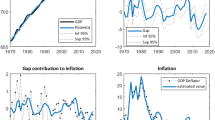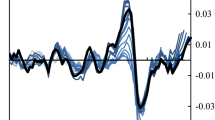Abstract
Rennison (Comparing alternative output gap estimations: a Monte Carlo approach, 2003) has provided simulation-based evidence showing that the joint use of extended multivariate filters and structural vector autoregression models is optimal for estimating potential output. We use this approach to estimate the two components of potential GDP: the full-employment labour input and trend labour productivity. This decomposition is useful for identifying sources of fluctuations in potential output. It reveals, for example, that the vigorous growth rate of U.S. potential GDP recorded during the second half of the 1990s is attributable to a fall in the structural rate of unemployment and a marked upswing in trend productivity growth.
Similar content being viewed by others
References
Andersen LC (1978) An explanation of movements in the labour force participation rate, 1957–76. Federal Reserve Bank of St. Louis Review (August)
Ball L, Mankiw NG (2002) The Nairu in theory and practice. J. Econo Perspect 16(4):115–136
Beveridge S, Nelson CR (1981) A new approach to decomposition of economic time series into permanent and transitory components with particular attention to measurement of the business cycle. J Monet Econo 7(2):151–174
Blanchard OJ, Katz LF (1997) What we know and do not know about the natural rate of unemployment. J Econo Perspectives 11(1):51–72
Blanchard OJ, Quah D (1989) The dynamic effects of aggregate demand and supply disturbances. Am Econo Rev 79(4):655–673
Butler L (1996) A semi-structural method to estimate potential output: combining economic theory with a time-series filter. Technical Report No. 77. Bank of Canada, Ottawa
Cayen J-P, van Norden S (2002) La fiabilité des estimations de l’écart de production au Canada. Bank of Canada Working Paper No. 2002–10
Clarida R, Galí J, Gertler M (1998) Monetary policy rules in practice: some international evidence. Euro Econo Rev 42(6):1033–1068
Cohen J, Dickens WT, Posen A (2001) Have the new human-resources practices lowered the sustainable unemployment rate? In: Krueger AB, Solow R (eds) The roaring nineties: can full employment be sustained? New York
Cooley TF, Dwyer M (1998) Business cycle analysis without much theory: a look at structural VARs. J Econo 83(1–2):57–88
Congressional Budget Office (CBO) (2004a) A summary of alternative methods for estimating potential GDP. Background paper
Congressional Budget Office (CBO) (2004b) The budget and economic outlook: an update
Demers F (2003) The Canadian Phillips curve and regime shifting. Bank of Canada Working Paper No. 2003–32
DeSerres A, Guay A (1995) Selection of the truncation lag in structural VARs (or VECMs) with long-run restrictions. Bank of Canada Working Paper No. 1995–9
Dupuis D (2004) The new Keynesian hybrid Phillips curve: an assessment of competing specifications for the United States. Bank of Canada Working Paper No. 2004–31
Ehrmann M, Smets F (2003) Uncertain potential output: implications for monetary policy. J Econo Dyn Control 27(9):1611–1638
Faust J, Leeper EM (1997) When do long-run identifying restrictions give reliable results? J Business Econo Statistics 15(3):345–353
Gerlach S, Smets F (1999) Output gaps and monetary policy in the EMU area. Eur Econo Rev 43(4–6):801–812
Gordon RJ (1998) Foundations of the goldilocks economy: supply shocks and the time-varying NAIRU. Brookings Papers Econo Activity (2):297–333
Johnson WR, Skinner J (1986) Labour supply and marital separation. Am Econo Rev 76(3):455–469
Jorgenson DW, Ho MS, Stiroh KJ (2002) Projecting productivity growth: lessons from the U.S. growth resurgence. Federal Reserve Bank of Atlanta Economic Review 87(3)
Katz LF, Krueger AB (1999) The high-pressure U.S. labour market of the 1990s. Brookings Papers on Economic Activity (1):1–65
Kichian M (1999) Measuring potential output within a state-space framework. Bank of Canada Working Paper No. 99–9
Kirkland K (2000) On the decline in average weekly hours worked. Monthly Labor Review (July)
Kuttner KN (1994) Estimating potential output as a latent variable. J Business Econ Stat 12(3):361–368
Lalonde R (1998) Le PIB potentiel des États-Unis et ses déterminants: la productivité de la main-d’œuvre et le taux d’activité. Bank of Canada Working Paper No. 1998–13
Lalonde R (2000) Le modèle USM d’analyse et de projection de l’économie amèricaine. Bank of Canada Working Paper No. 2000–19
Laubach T (2001) Measuring the NAIRU: evidence from seven economies. Rev Econo Statistics 83(2):218–231
Laxton D, Tetlow R (1992) A simple multivariate filter for the measurement of potential output. Technical Report No. 59. Ottawa: Bank of Canada
Mise E, Kim T-H, Newbold P (2005) On suboptimality of the Hodrick-Prescott filter at time series endpoints. J Macroecon 27(1):53–67
Oliner SD, Sichel DE (2002) Information technology and productivity: where are we now and where are we going? Federal Reserve Board. Manuscript
Orphanides A, van Norden S (2002) The unreliability of output-gap estimates in real time. Rev Econo Stat 84(4):569–583
Parkman AM (1992) Unilateral divorce and the labour-force participation rate of married women, revisited. Am Econ Rev 82(3):671–678
Phillips PCB (1998a) Impulse response and forecast error variance asymptotics in nonstationary VARs. J Econ 83(1–2):21–56
Phillips PCB (1998b) Econometric analysis of Fisher’s equation. Cowles Foundation Discussion Paper No. 1180
Rennison A (2003) Comparing alternative output-gap estimators: a Monte Carlo approach. Bank of Canada Working Paper No. 2003–8
Shimer R (2001) The impact of young workers on the aggregate labour market. Q J Econ 116(3):969–1008
Smets F (2002) Output gap uncertainty: does it matter for the Taylor rule? Empiri Econ 27(1):113–129
Staiger D, Stock JH, Watson MW (2001) Prices, wages, and the U.S. NAIRU in the 1990s. In: Krueger AB, Solow R (eds) The roaring nineties: can full employment be sustained? New York
St-Amant P, van Norden S (1997) Measurement of the output gap: a discussion of recent research at the Bank of Canada. Technical Report No. 79. Bank of Canada, Ottawa
Svensson L (1997) Inflation forecast targeting; implementing and monitoring inflation targets. Euro Econ Rev 41(6):1111–1146
Taylor J (1993) Discretion versus policy rules in practice. Carnegie-Rochester Conference Series on Public Policy 39(0):195–214
Tetlow RJ (2000) Uncertain potential output and monetary policy in a forward-looking model. Federal Reserve Board. Manuscript
Author information
Authors and Affiliations
Corresponding author
Rights and permissions
About this article
Cite this article
Gosselin, MA., Lalonde, R. An Eclectic Approach to Estimating U.S. Potential GDP. Empirical Economics 31, 951–975 (2006). https://doi.org/10.1007/s00181-006-0063-8
Received:
Accepted:
Published:
Issue Date:
DOI: https://doi.org/10.1007/s00181-006-0063-8




